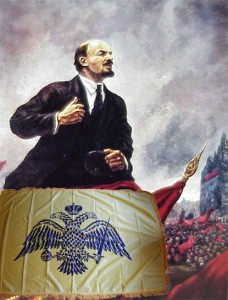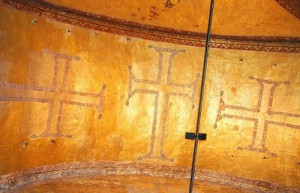 Drew asks if we can consider the Soviet Empire as a continuation of Byzantium. It’s well known that Moscow at one time considered itself as the ‘third Rome’ (or second Constantinople). There were some compelling reasons to think this. Moscow was originally built on seven hills like Rome and Constantinople, Russian troops had been serving in the Byzantine army since the 10th century, and the Russian alphabet, Orthodoxy, and (to some degree) culture had been provided by Byzantium. When Ivan III married Sophia Paleologus- the niece of the last Byzantine emperor- he had a strong claim to be the legitimate heir to the Roman Empire.
Drew asks if we can consider the Soviet Empire as a continuation of Byzantium. It’s well known that Moscow at one time considered itself as the ‘third Rome’ (or second Constantinople). There were some compelling reasons to think this. Moscow was originally built on seven hills like Rome and Constantinople, Russian troops had been serving in the Byzantine army since the 10th century, and the Russian alphabet, Orthodoxy, and (to some degree) culture had been provided by Byzantium. When Ivan III married Sophia Paleologus- the niece of the last Byzantine emperor- he had a strong claim to be the legitimate heir to the Roman Empire.
Setting aside Ivan for a moment, we can dismiss the Soviet Empire entirely. It was a reaction against the very institutions which drew their inspiration from Byzantium. It replaced Orthodoxy with its own saints- Marx, Lenin, Stalin, etc- and did away with the traditional and political underpinnings of the Tsardom.
A better case can be made that the Russian Revolution of 1917 ended Byzantium, but there are still some serious problems with this. For all of the similarities the Russian Empire was a unique entity. They added their own influences into the mix and ultimately drew their inspiration from the Slavic world not the Greek one. More importantly, they didn’t think of themselves as a continuation so much as use imperial Byzantine symbols to legitimize their own rule. Ivan wrapped himself in the double eagle because it added to his prestige, not because he thought of himself as a new Constantine. He was more interested in keeping Ivan alive (and in power) than in resuscitating Byzantium. Constantinople was only important so far as it aided that goal.
A case in point is the 2009 Russian video “Death of an Empire: the Byzantine Lesson” which is narrated by Vladimir Putin’s father-confessor. (you can watch the entire thing on youtube) The film draws a parallel between Byzantium and Russia and the message is that the West is not to be trusted. The Byzantine Empire is pressed into service as a surrogate Russia, and its fall is a warning not to fall into the debt of the West. But the narrator’s call is not to restore Byzantium, it is to restore the Orthodox Russian Empire; an entity not a successor.
 Craig asks how much Leo’s Syrian origin influenced his iconoclasm. The traditional answer is that it was a major factor and in fact many textbooks present iconoclasm as if it were an obvious (and somewhat unavoidable) outgrowth of Islamic contact with the Empire. But I think this is misleading. Leo did indeed have an eastern mindset. He was born in Syria and clearly had a good handle on the Arab psyche. This was recognized by the emperor Justinian II who sent him on a diplomatic mission to the East to keep the various tribes from uniting against the empire. While there he faced two huge Arab armies which had come to sack the major imperial city of Amorium and somehow managed to talk each of them into going home empty-handed. (Probably by hinting that he would soon be emperor and would make a useful puppet when the time came. Each Arab commander decided to wait for the bigger prize.)
Craig asks how much Leo’s Syrian origin influenced his iconoclasm. The traditional answer is that it was a major factor and in fact many textbooks present iconoclasm as if it were an obvious (and somewhat unavoidable) outgrowth of Islamic contact with the Empire. But I think this is misleading. Leo did indeed have an eastern mindset. He was born in Syria and clearly had a good handle on the Arab psyche. This was recognized by the emperor Justinian II who sent him on a diplomatic mission to the East to keep the various tribes from uniting against the empire. While there he faced two huge Arab armies which had come to sack the major imperial city of Amorium and somehow managed to talk each of them into going home empty-handed. (Probably by hinting that he would soon be emperor and would make a useful puppet when the time came. Each Arab commander decided to wait for the bigger prize.)
In his negotiations with the enemy commanders, Leo wouldn’t have needed a translator. Arabic was most likely his first language, which is one of the reasons why Islam is suspected as being an influence on him (even though it merely proves that not every native Arabic speaker was a Muslim). It’s tempting to think that the Islamic stricture against images was the inspiration for iconoclasm, but it more likely a development of Monophysitism- the Christian heresy that rejected Christ’s humanity in favor of his divinity. If Christ was purely divine then depicting him as a man was a form of heresy. Monophysitism had deep roots in Syria, and Leo wouldn’t have been the first emperor to pay lip service to Orthodoxy while harboring private Monophysitic beliefs.
Added to this natural dislike of icons was probably a bit of pique. When the Saracen army and navy showed up to besiege Constantinople Leo had been preparing for five months. It was he who had bolstered the city’s morale, intrigued with the Arab commanders outside the walls to keep them divided, incited most of the galley slaves of the relieving Muslim armada to revolt, and finally convinced the Bulgarian army to march down to Constantinople and deliver the coup de grace. And yet credit for Constantinople’s deliverance was popularly given to the icon of Mary that had made daily circuits of the city’s walls and was believed to have the city under its protection.
Leo gave a sermon thundering against Icons in the Hagia Sophia a few weeks later. When that produced no great outcry he issued his famous decree.
 Drew asks if we can consider the Soviet Empire as a continuation of Byzantium. It’s well known that Moscow at one time considered itself as the ‘third Rome’ (or second Constantinople). There were some compelling reasons to think this. Moscow was originally built on seven hills like Rome and Constantinople, Russian troops had been serving in the Byzantine army since the 10th century, and the Russian alphabet, Orthodoxy, and (to some degree) culture had been provided by Byzantium. When Ivan III married Sophia Paleologus- the niece of the last Byzantine emperor- he had a strong claim to be the legitimate heir to the Roman Empire.
Drew asks if we can consider the Soviet Empire as a continuation of Byzantium. It’s well known that Moscow at one time considered itself as the ‘third Rome’ (or second Constantinople). There were some compelling reasons to think this. Moscow was originally built on seven hills like Rome and Constantinople, Russian troops had been serving in the Byzantine army since the 10th century, and the Russian alphabet, Orthodoxy, and (to some degree) culture had been provided by Byzantium. When Ivan III married Sophia Paleologus- the niece of the last Byzantine emperor- he had a strong claim to be the legitimate heir to the Roman Empire.